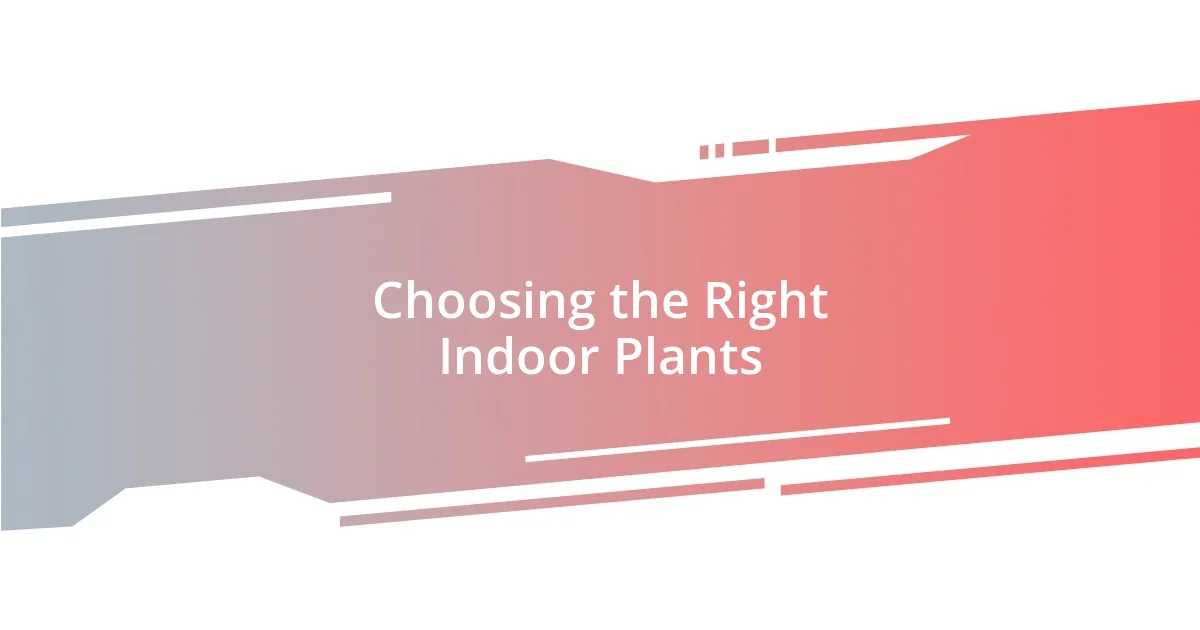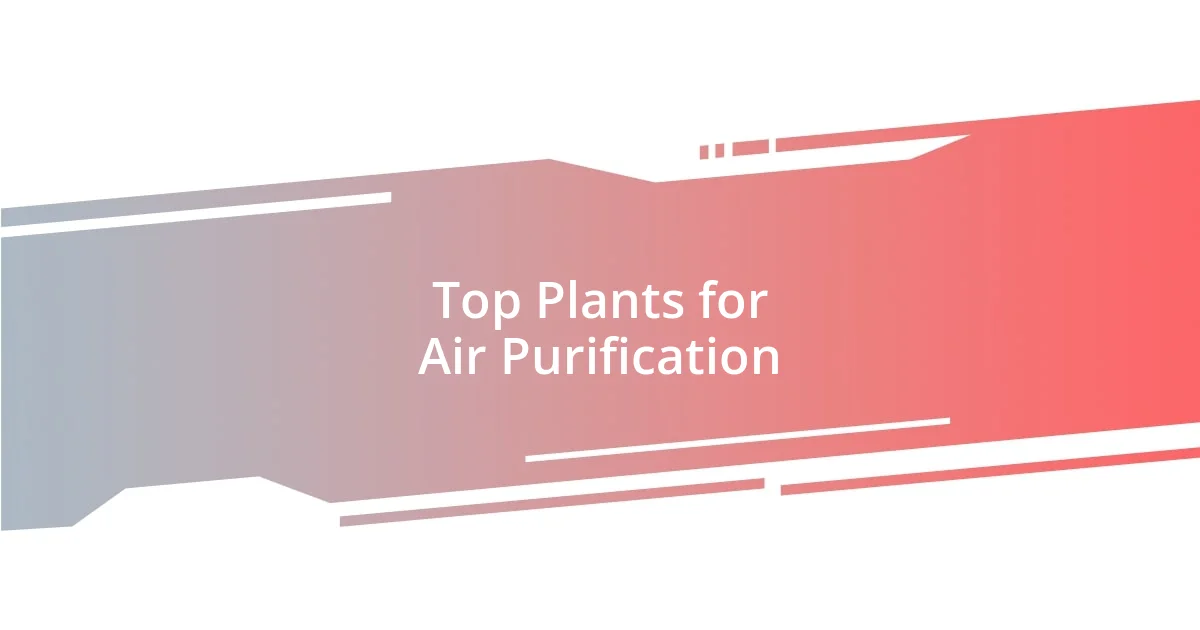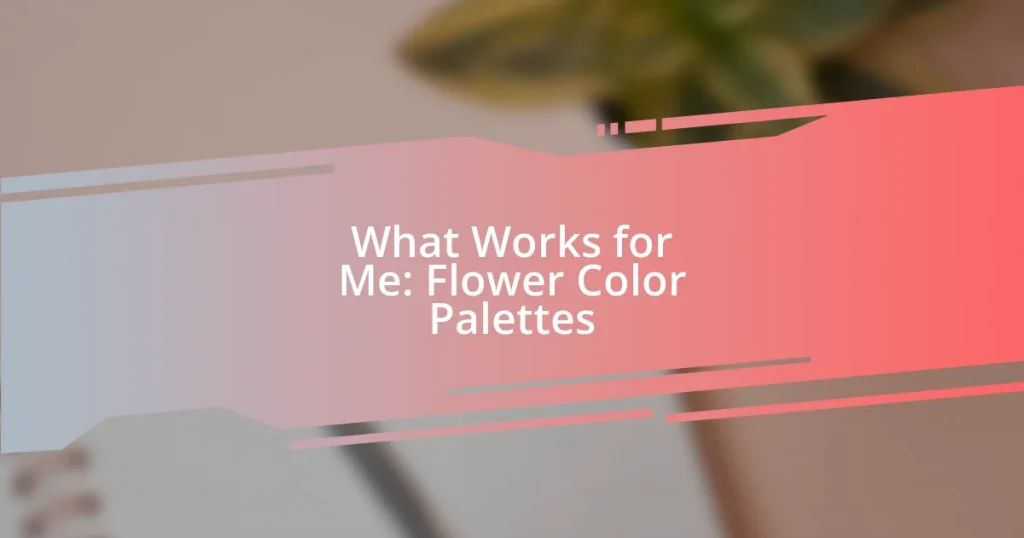Key takeaways:
- Indoor plants like snake plants and spider plants significantly improve air quality by filtering toxins and enhancing emotional well-being.
- Choosing the right plants involves considering light requirements, care levels, toxin removal capabilities, aesthetics, and safety for pets.
- Combining plants with tools like air purifiers and essential oil diffusers further boosts air cleanliness and creates a more inviting atmosphere.

Understanding Air Quality Benefits
When I think about air quality, I often remember the moment I brought home my first peace lily. Just a single plant transformed my space—not just visually but in the air I breathed. Studies show that certain plants can filter out harmful toxins, and witnessing this effect firsthand was eye-opening. It makes me wonder, how much better could we feel in our homes if we all embraced the power of greenery?
Imagine coming home after a long day to an environment filled with fresh, clean air. That’s the beauty of using plants like spider plants or snake plants, which are known for their air-purifying qualities. I’ve noticed that on days when I don’t tend to my plants, the air somehow feels heavier, almost stifling. It’s incredible how living things can elevate our well-being simply by existing in our spaces.
The emotional impact of improved air quality isn’t just about physical health—it’s about creating a serene sanctuary in our busy lives. I’ll never forget the relief I felt when I realized my home office could double as a peaceful retreat, thanks to my collection of air-purifying plants. It leads me to reflect: how much of our state of mind can be influenced by the air we breathe? It’s clear to me that nurturing plants can nurture our health too.

Choosing the Right Indoor Plants
Choosing the right indoor plants can feel overwhelming, but it’s all about aligning with your space and lifestyle. For instance, I adore having a few pothos plants scattered around my home. Not only are they incredibly forgiving and easy to care for, but they also thrive in low light, making them perfect for my dimly lit corners. By picking plants that suit your environment, you’re setting the stage for a flourishing indoor ecosystem.
Here are some key factors to consider when choosing your air-purifying plants:
- Light Requirements: Opt for plants that match the natural light available in your home.
- Care Level: Assess how much time you can realistically devote to plant care. Some, like succulents, need less attention than others, such as ferns.
- Toxins Removal: Select plants that are known specifically for removing toxins such as formaldehyde or benzene.
- Aesthetics: Choose plants that not only purify the air but also enhance your home’s decor. I find the vibrant leaves of a rubber plant add a beautiful touch to my living room.
- Safety: Keep in mind any pet allergies or toxin risks; for example, lilies can be harmful to cats.
By carefully considering these factors, you can create a thriving environment that purifies your air while also nurturing your soul.

Top Plants for Air Purification
Selecting the right plants for air purification can truly transform your living space. From my experience, the snake plant stands out as a top choice. This resilient plant not only thrives on neglect but also works tirelessly to remove toxins like formaldehyde while releasing oxygen at night. It’s a remarkable companion when I’m focused on my nighttime routine, breathing in fresh air as I unwind.
While I’ve experimented with various plants, the spider plant has carved a special place in my heart. It’s fascinating to witness how it produces tiny “baby” plants, effortlessly spreading its green charm. Whenever I walk past it, I’m reminded of the importance of resilience and growth, both in my garden and my life. Plus, it’s a powerful player in absorbing pollutants, making it the perfect addition to any family room.
If you’re looking for a more exotic option, consider the bamboo palm. I remember visiting a friend’s house and being mesmerized by the lush, tropical vibe it added to their living room. Not only does it purify the air by filtering out benzene and formaldehyde, but its elegant stature also brings a sense of calmness to the environment. The combination of aesthetics and air quality makes it an essential pick for anyone aiming to breathe easier.
| Plant | Key Benefits |
|---|---|
| Snake Plant | Removes formaldehyde; releases oxygen at night |
| Spider Plant | Absorbs pollutants; easy to propagate |
| Bamboo Palm | Filters benzene and formaldehyde; enhances aesthetic appeal |

Caring for Air-Purifying Plants
Caring for air-purifying plants can be both rewarding and straightforward. I’ve found that the key to healthy growth lies in understanding their specific needs. For instance, I always check the moisture level before watering—overwatering has been my pitfall more times than I can count. It’s incredible how a simple act can transform your plant from perky to droopy.
Fertilizing my plants regularly has made a significant difference too. I use a diluted organic fertilizer during the growing season. Observing the vibrant new growth that follows is a reminder of how a little extra care can yield beautiful results. It prompts me to think about what other areas of my life could flourish with just a bit of attention—how about you?
Lastly, I find that dusting off the leaves is essential for maximizing their air-purifying capabilities. It sounds simple, but I remember the first time I noticed how much more light my plants were soaking up after a good cleaning. You wouldn’t believe how this small maintenance check can make a significant impact on their health—and the air quality in my home!

Placement Tips for Optimal Impact
I’ve learned that the placement of my plants is nearly as important as the choice itself. For instance, I always position my snake plant in a bright corner, where it can soak up the filtered sunlight. The way it seems to stretch and reach toward the light reminds me that we all thrive when given the right environment—don’t you think?
When arranging my spider plant, I usually opt for a hanging basket. There’s something so charming about watching those little “babies” dangle down; it feels like they’re filled with life. Plus, I’ve noticed that elevating them not only adds a playful touch to the room but also increases their air purifying potential. Have you ever thought about how plants can change the entire vibe of a space?
I recommend keeping plants close to frequently used spaces, like the kitchen or living room. I once placed my bamboo palm on my kitchen counter, and the fresh air it produced was palpable while I prepped meals. It became a talking point when friends came over, sparking meaningful conversations about nature and wellness. It’s amazing how a simple plant can enhance both air quality and social interactions in your home. What’s your favorite spot for a plant?

Combining Plants with Other Methods
Integrating plants with other air-purifying methods has been a game-changer for me. For example, I’ve paired my potted peace lily with a high-quality air purifier. The combination has created a fresh, inviting atmosphere that feels like a breath of fresh air—literally! Why stop at just one method when you can amplify the benefits of both?
I’ve also experimented with essential oil diffusers alongside my indoor plants. Every evening, I mix a few drops of lavender oil, which not only uplifts my mood but complements the natural air-cleansing abilities of my plants. It’s fascinating how the soothing scent envelops my space and offers a relaxing vibe. Have you ever interconnected scents with your plants to elevate your environment?
Moreover, maintaining good airflow is crucial. I’ve found that opening windows strategically while ensuring my plants are positioned nearby creates a perfect balance. It transforms the energy in my home, bringing in fresh outdoor air while letting my plants do their magic. Isn’t it interesting how nature and architecture can collaborate for better air quality?

Measuring Air Quality Improvements
Tracking the air quality improvements in my home has been a rewarding journey. I often turn to air quality monitors that measure the levels of particulates and volatile organic compounds (VOCs) before and after I introduce new plants. It’s always gratifying to see the numbers drop, reminding me just how much these green companions contribute to my well-being.
One memorable moment was when I decided to place a few plants in my bedroom. Initially, my air quality measurements revealed moderate levels of indoor pollutants. After a month of caring for my peace lily and spider plant, I noticed significant reductions. It felt like a triumph, not just for my plants but for the serene atmosphere they helped create. Who wouldn’t feel a little happier surrounded by thriving greenery?
I also keep a log of my overall mood and respiratory comfort alongside the air quality measurements. It’s fascinating to correlate better air quality with improved sleep and more vibrant energy levels during the day. Have you ever considered how connected our environment is to our personal wellness? It truly shows just how powerful plants can be, both scientifically and emotionally.















